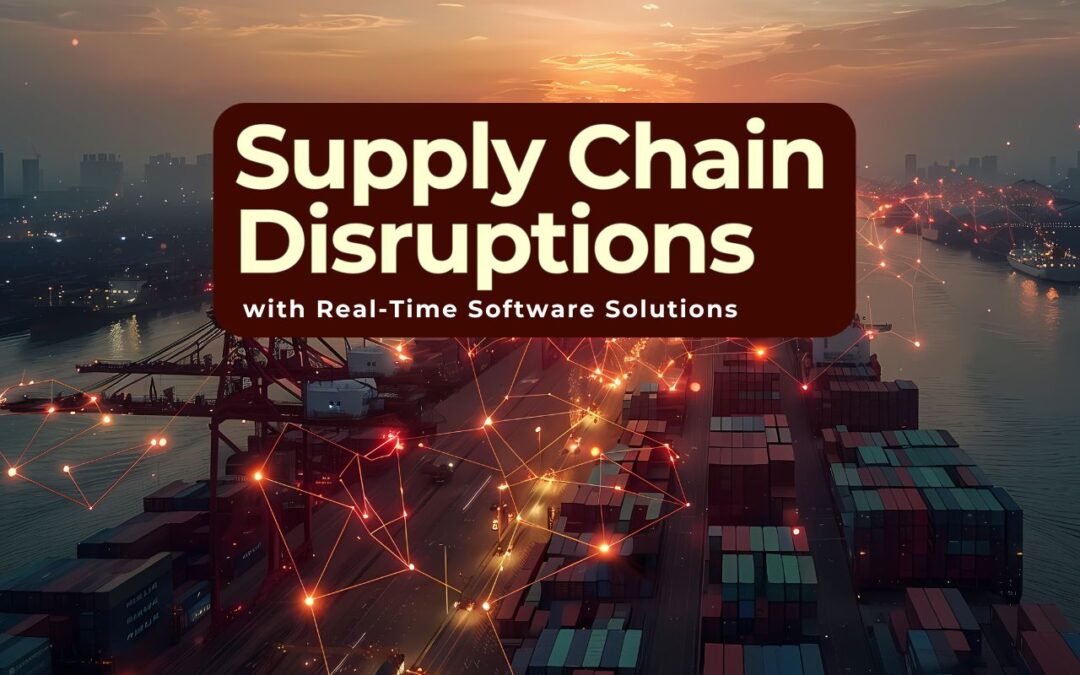In today’s hyper-connected and fast-paced global economy, supply chain disruptions are no longer a rare occurrence. From pandemics and natural disasters to geopolitical tensions and cyberattacks, businesses face a myriad of challenges that can cause significant disruptions in their supply chains. These interruptions not only result in delayed deliveries and increased costs but also have long-term implications for customer trust and brand reputation.
To navigate this volatile landscape, companies are increasingly turning to real-time software solutions to enhance supply chain visibility, resilience, and responsiveness. This blog explores how real-time software technologies are helping businesses overcome supply chain disruptions, the key features of these solutions, and practical strategies for successful implementation.
Understanding Supply Chain Disruptions
Supply chain disruptions refer to any unforeseen events that interrupt the normal flow of goods and materials within a supply chain. These events can originate from a variety of sources:
- Natural Disasters: Earthquakes, floods, hurricanes
- Pandemics: COVID-19 brought global supply chains to a standstill
- Geopolitical Conflicts: Trade wars, sanctions, border closures
- Cybersecurity Threats: Ransomware attacks on logistics providers
- Supplier Failures: Bankruptcy, poor quality control, capacity issues
Traditional supply chain systems are often linear and siloed, which makes them ill-equipped to handle dynamic changes in real time. This is where real-time software solutions come into play.
The Role of Real-Time Software in Supply Chain Management
Real-time software solutions integrate advanced technologies like the Internet of Things (IoT), artificial intelligence (AI), machine learning (ML), and cloud computing to offer dynamic visibility into every aspect of the supply chain. Here’s how they make a difference:
1. Enhanced Visibility and Transparency
Real-time tracking tools allow companies to monitor shipments, inventory levels, and supplier performance as events unfold. This visibility is crucial in identifying bottlenecks and rerouting shipments when needed.
2. Proactive Risk Management
AI and ML algorithms can analyze historical data and current trends to predict potential disruptions. For instance, predictive analytics can forecast delays due to weather conditions or political unrest.
3. Streamlined Communication
Collaboration platforms integrated with real-time data help all stakeholders—from suppliers to logistics providers—stay informed and aligned, reducing miscommunication and delays.
4. Automated Decision-Making
Software solutions can automate routine tasks such as order fulfillment, inventory replenishment, and supplier evaluation. This frees up human resources to focus on strategic issues.
5. Scalability and Flexibility
Cloud-based systems enable businesses to scale operations up or down depending on demand, helping them adapt quickly to changing circumstances.
Key Features of Real-Time Supply Chain Software
When selecting a real-time supply chain management (SCM) solution, businesses should look for the following essential features:
- Real-Time Inventory Management: Live tracking of stock levels across multiple locations
- Advanced Analytics Dashboards: Visual insights into performance metrics and risk indicators
- Supplier Portals: Centralized communication and document exchange with suppliers
- Transport Management Systems (TMS): Real-time shipment tracking and route optimization
- Warehouse Management Systems (WMS): Integration with IoT sensors for real-time asset tracking
- Mobile Accessibility: On-the-go access for field agents and warehouse staff
- Integration Capabilities: Seamless integration with ERP, CRM, and other enterprise systems
Real-World Examples of Success
1. Walmart
Walmart uses real-time data analytics to monitor inventory and predict stock shortages before they happen. Their automated replenishment system ensures that shelves are restocked promptly, minimizing revenue loss.
2. Maersk
The shipping giant employs IoT and AI-driven software to track containers and manage logistics. During the pandemic, this helped them reroute shipments and avoid congested ports.
3. Cisco
Cisco’s supply chain digital transformation involves a centralized command center that provides real-time visibility into all supply chain activities. This has significantly reduced lead times and improved service levels.
Steps to Implement Real-Time Software in Your Supply Chain
Step 1: Assess Current Capabilities
Conduct a gap analysis to identify areas where visibility and responsiveness are lacking.
Step 2: Define Objectives
Set clear goals, such as reducing lead times, improving on-time delivery, or enhancing risk management.
Step 3: Choose the Right Technology
Select software that aligns with your supply chain complexity and scalability needs. Cloud-based platforms are generally more flexible and cost-effective.
Step 4: Train Your Team
Ensure that staff across all levels are trained to use the new tools effectively. Consider involving end-users in the selection and testing process.
Step 5: Monitor and Optimize
Continuously track performance metrics and use analytics to identify improvement opportunities.
Overcoming Implementation Challenges
Despite their benefits, implementing real-time software solutions comes with its own set of challenges:
- High Initial Costs: Investing in advanced technology can be expensive. Start small with pilot projects before scaling.
- Data Integration Issues: Merging data from disparate sources can be complex. Choose platforms with robust API capabilities.
- Resistance to Change: Employees may be reluctant to adopt new systems. Leadership should champion the initiative and communicate its value.
- Cybersecurity Risks: Real-time data sharing increases exposure to cyber threats. Invest in strong encryption and data protection protocols.
The Future of Supply Chain Management
The supply chain of the future will be agile, autonomous, and resilient. Real-time software solutions will play a pivotal role in this transformation by enabling:
- Self-Healing Supply Chains: Systems that detect issues and autonomously take corrective actions
- Hyper-Automation: Combining AI, ML, and robotics to automate complex processes
- Sustainability Tracking: Monitoring carbon footprints and compliance with environmental regulations in real time
- Blockchain Integration: Enhancing transparency and trust across all supply chain tiers
Final Thoughts
In an era marked by constant change and unpredictability, real-time software solutions are no longer a luxury but a necessity for resilient supply chain management. They offer the visibility, speed, and intelligence that businesses need to respond effectively to disruptions and seize emerging opportunities.
Companies that invest in these technologies not only protect themselves from the impacts of current disruptions but also position themselves for long-term success in an increasingly competitive landscape. By embracing digital transformation today, supply chains can become tomorrow’s competitive advantage.













